"We meet aliens every day who have something to give us. They come in the form of people with different opinions." -William Shatner
It’s been another big week here at Starts With A Bang, with stories covering the Universe near and far. Although the biggest announcements seemed to shatter our picture of how things are, this week was all about keeping it in perspective. There are lots of ideas -- good and bad -- floating around, but in the end, data and experiments will be the ultimate arbiter. Here’s what we've covered over the past week:
- How do we know the Universe is 13.8 billion years old? (for Ask Ethan),
- Dark matter riches: why some galaxies have more than others (for Mostly Mute Monday),
- Exoplanets: from fluke to fact (a great historical guest post by Sabine Hossenfelder),
- Record-breaking galaxy cluster confirms dark matter Universe,
- A Young, Dusty, Disk-Bearing Star Reminds Us 'Alien Megastructures' Aren't The Only Answer,
- Fifth Fundamental Force: Fact or Fiction?, and
- NASA's impossible space engine, the EMdrive, passes peer review.
As always, there's an ongoing conversation to have, so let's investigate all that we can on this edition of our comments of the week!
The Port Newark-Elizabeth Marine Terminal, easily showing detail on cars, from satellite imagery. Image credit: NASA.
From Omega Centauri on mapping resolution: "We are trying to image an object on the bottom of a swimming pool, wave motion of the surface is constantly defocusing the image. If I assume the blurring occurs at a height of 5KM and is a single arc second, I get atmospheric blurring as about 24cm."
Of course, there's a fundamental problem with imaging anything on the Earth's surface, and that's the fact that you have to contend with the atmosphere. The blurring effect we imagine may be small, but it's still present, and is dependent on the amount of turbulent airflow, wind speed and the temperature gradients. Perhaps fortunately, this effect is also wavelength dependent, and is being worked on for a different reason: the breakthrough starshot.
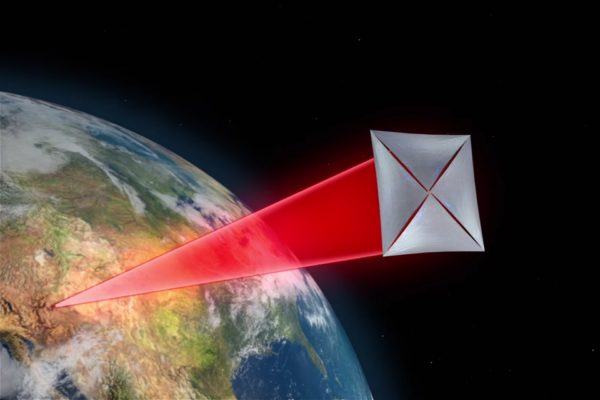 One key to success in an endeavor like a ground-based laser sail is to have as close to perfect laser collimation as possible, even through the atmosphere. Image credit: the Breakthrough Starshot initiative.
One key to success in an endeavor like a ground-based laser sail is to have as close to perfect laser collimation as possible, even through the atmosphere. Image credit: the Breakthrough Starshot initiative.
It's much cheaper to build a laser array on the ground than in space, but firing your lasers through the atmosphere results in a loss of collimation for the same reason the atmosphere "blurs" light of any form. But according to the breakthrough initiative:
Breakthrough Starshot aims to achieve the diffraction limit for an optical system of laser beams across 0.2-1km, which is 1-2 orders of magnitude beyond existing demonstrations. There are no fundamental physics limitations to achieving this improvement.
Of course, another way to improve it is to do binocular observations with large-dish telescopes rather than single-dish observation. This can get seeing in the infrared down to a resolution of 40 milli-arc-seconds, or a factor of 25 better than Omega's calculations. (1 cm resolution!) This is what Keck does from the ground, and there's no reason we can't equal that from space going the other way. The only question is whether it's worth it.
From Denier on WFIRST hatred: "This is what has me so bent out of shape about WFIRST. The total budget for DigitalGlobe’s WorldView-4, including design from the ground up, construction, launch, and insurance is US$835 million. From proposal to first light is 9 years.
Contrast that with NASA who doesn’t have to pay to design or build the KH11 2.4m Stubby Hubbles. Even with the massive head start NASA needs US$2.7 billion (and rising), and 15-20 years."
So I don't fully understand this. With James Webb or with any new, state-of-the-art, cutting-edge scientific instrument, you're often building special, one-of-a-kind tools for a unique assembly that have never been made before and will never be made again. Normally, development, construction, testing and deployment occur on timescales of around a decade. WFIRST was accepted as the #1 priority for NASA's decadal survey -- to be the flagship mission of the 2020s -- in the early 2010s. Shortly after (I believe 2012) was when the 2.4m Hubble clones were received by NASA, and after some debate, they decided it was worth using the free telescope rather than building WFIRST at the original (smaller) size. But all the instruments need to be built, all the people need to be hired, the full testing/maintenance cost needs to be factored in and the cost of WFIRST must include all the ongoing costs as well.
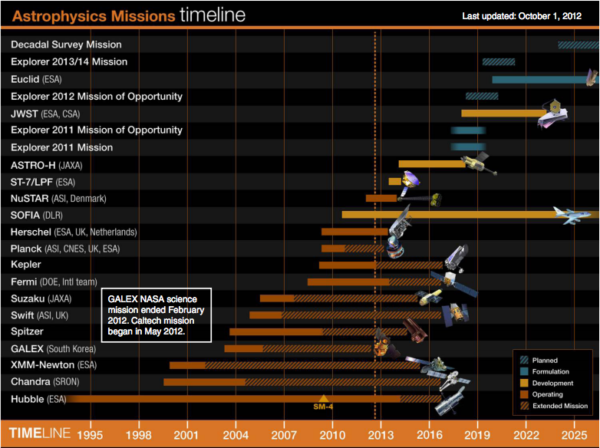 The Astrophysics mission timeline from NASA's astrophysics implementation plan, 2013. Note how the Decadal mission -- which was not yet chosen as of October 2012 but is now WFIRST -- still has 2024 as its launch date. Image credit: NASA.
The Astrophysics mission timeline from NASA's astrophysics implementation plan, 2013. Note how the Decadal mission -- which was not yet chosen as of October 2012 but is now WFIRST -- still has 2024 as its launch date. Image credit: NASA.
These decadal missions normally run about $5 billion apiece, so WFIRST is a bargain there. And I don't know where you get 15-20 years; it's 2016 and launch is still slated for 2024! WFIRST is basically superpowered, multiwavelength SDSS from space, except doing much more of the sky and with planet-finding and supernova-hunting capabilities. WorldView-4 is basically unchanged from WorldView-2 and WorldView-3. That's why it's so much cheaper. If you wanted to build WFIRST-4, it'd be cheaper, too.
The size of our visible Universe (yellow), along with the amount we can reach (magenta). Image credit: E. Siegel, based on work by Wikimedia Commons users Azcolvin 429 and Frédéric MICHEL.
From Richard on older civilizations: "Considering the age of the Universe is 13.8 billion years old it makes me appreciate my 5.46 billion year old ”possible” NWA 7325 Mercury Meteorite [...] It makes me wonder sometimes if we will ever encounter anything older, an advanced civilization perhaps?"
Well, there are at least 10^22 potentially habitable planets in the observable Universe, and about 3% of them are potentially "encounterable" by us. But we are a young civilization, make no mistake about it. We can talk about how "Earth-like" conditions may have arisen billions of years before they did on Earth, but that doesn't mean much; we've only been a "civilization" in the technological sense for maybe a century or two (or less), depending on how you measure it. If aliens were like us and they came to Earth 20,000 years ago, would they have said, "nothing to see here" and simply moved along? Perhaps they would. Perhaps we will. But if we can survive and thrive for just a few thousand years more, we may become more advanced than anything you're imagining.
Also, Michael Kelsey had it right,
"The Solar System has been rather precisely dated, using isotopic rations from CAI’s, to 4.5682 Gy (yes, that’s five digits of precision). Your putative Mercury meteorite is presumably 4.56 Gy old, not “5.46”."
Most meteorites on Earth from other planets come from less time ago than that, in the sense that there was an impact on Mercury, it kicked up rocks, one made it to Earth, and now you have a fragment of it. (In the best-case scenario.) But although it may be 4+ billion years since any thing changed about it on the Mercurian surface, it's likely been much less than that since it arrived on Earth.
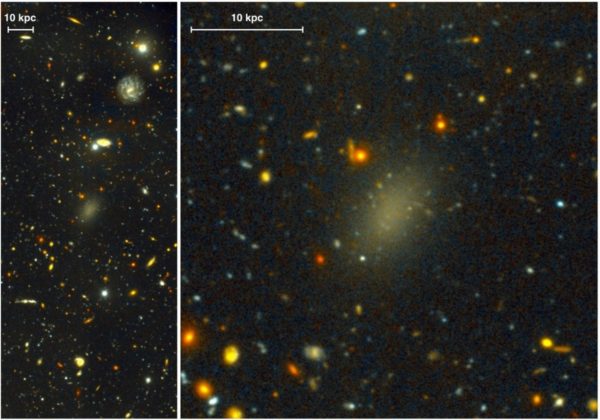 An image of galaxy Dragonfly 44, recently discovered to have the largest offset between normal matter and dark matter of any known, large galaxy. Image credit: Pieter van Dokkum, Roberto Abraham, Gemini Observatory/AURA.
An image of galaxy Dragonfly 44, recently discovered to have the largest offset between normal matter and dark matter of any known, large galaxy. Image credit: Pieter van Dokkum, Roberto Abraham, Gemini Observatory/AURA.
From Omega Centauri (again!) on matter stripping: "If the normal matter was stripped away by (gas) ram pressure, it must have happened before many stars were formed, otherwise a decent faction of the mass would have been in the forms of stars,which aren’t stripped out by fast travel through the intergalactic medium. So I think this new one is still an enigma."
Ah, but this isn't the standard intergalactic medium; this is a galaxy in the coma cluster of galaxies. What would have happened if this galaxy had a rapid collision with a giant elliptical galaxy? What would happen to the stars, the gas, etc., as it collided?
Do you see the "stellar streams" being siphoned off of this galaxy? That's nothing! Imagine a collision large enough to pull nearly all the baryons out of the galaxy, yet that the initial speed was large enough that the dark matter component remained unbound from the central galaxy.
I'm not saying, "oh, that's definitely it," but this is a puzzle with a number of straightforward scenarios. It doesn't mean it's less cool, but it does mean that the voices you hear going, "oh, this galaxy is weird, maybe let's invent some new knobs to turn on the physics machine" had better look at the knobs we already have instead. They're already doing pretty great!
From William Murphy on the origin of boron: "Your description of the origin of Boron by spallation got me to thinking about the two main sources of boron on earth, Turkey and California.
If the early earth was struck by a cosmic ray stream big enough to penetrate and have an entry and exit point, on opposite sides of the earth, would that be a likely scenario for borons relative abundance and geographical localization?"
There are a lot of ways to answer this, and honestly, Michael Kelsey did a great job, so I'm reproducing his answer first.
"No, it wouldn’t work, and you should be able to work out for yourself why not. The most important word is “flux,” the rate of incoming particles per unit area per second. The second most important word is “product,” the number of atoms of boron (in this case) you want to produce.
For simplicity, you can assume perfect (100%) efficiency: every single incoming cosmic ray produces one boron atom. In reality, of course, the efficiency for an single species is tiny, as spallation produces a broad spectrum.
Start with an estimate of the total number of atoms of boron in each region, the approximate area of each region, and from those, work out what the flux would have to be. Also, estimate how _fast_ that flux would have to be delivered in order to produce all the boron in a limited area, before the Earth’s rotation spread that area out too much."
There are a lot of reasons why this wouldn't work, but even if you threw all of these (correct) reasons that Michael gave away, there's another problem: what would the by-products be? Most of Earth is made of silicon dioxide: silicon and oxygen atoms. If you want your cosmic rays to produce boron, what else must they produce? If you're going from oxygen, you'd need lithium (or lighter); if you're going from silicon, you'd need fluorine (or lighter). You'd also only get "surface" boron, as you wouldn't get penetration deep into the Earth. But this brings up the real killer: cosmic rays have to go through the atmosphere, and the atmosphere is where this "showering" really happens.
 The production of a cosmic ray shower, produced by an incredibly energetic particle from far outside our Solar System. Image credit: Pierre Auger Observatory, via http://apcauger.in2p3.fr/Public/Presentation/.
The production of a cosmic ray shower, produced by an incredibly energetic particle from far outside our Solar System. Image credit: Pierre Auger Observatory, via http://apcauger.in2p3.fr/Public/Presentation/.
The whole point of spallation isn't that something created elements once the Earth was already here, but rather that something created these elements throughout the Universe in space and over time: once the first heavy elements were already in place. Now, these elements become a part of the interstellar medium, and get incorporated in the formation of new planets and stars. That is where our boron comes from! The reason it's on the surface in some locations is the same reason that any elements form "veins" of materials on our world: the geological dynamics of Earth. But that's a science question for another day!
Composite image of the Bullet Group showing galaxies, hot gas (shown in pink) and dark matter (indicated in blue). Dark photons could never explain this gravity alone. Image credit: ESA / XMM-Newton / F. Gastaldello (INAF/IASF, Milano, Italy) / CFHTLS
From axil on dark photons, "Do you [believe] that dark matter is caused by dark photons?"
No. No one does. The dark photon idea is that there's a "dark electromagnetism" that couples to dark matter only, the way that electromagnetism couples to normal matter but not dark matter. But I don't believe there's a good reason to think dark photons exist at all; there's certainly no good evidence for it. (I'm still waiting for the "fifth force particle" the Hungarian team found to be confirmed before I give it much credulity.) But under no circumstances could a dark photon, which would behave as radiation, account for the missing mass problems of the Universe.
Image credit: public domain art by CapnHack, via http://energyphysics.wikispaces.com/Proto-Dyson+Sphere.
From PJ on alien megastructures, "Somehow, I feel any alien society would not usurp their planets resources to capture their suns energy. There would not be enough planet left after completion, methinks."
Well, why use your own planet? Why not mine Mercury or Mars and use their resources to build what you want to build? But I also don't understand why, if you were going to build anything like this, you'd put it so far out? Surely, building a large, energy-capturing structure closer to your parent star would be the more efficient way to go? Remember how flux works; why would you go 100 times farther away, to have to build something 10,000 times as large to collect the same amount of energy? Just build it in close and "beam" the energy over. What's the worst that could happen?
From eric in response to PJ's comment, "yeah, no truly intelligent species would poison/destroy its own long-term ecosystem for some comparatively short-term gain. Why, they’d have to be crazy to do that!"
I lol'ed.
From anonymous longtime reader on the comment section: "Please reconsider the decision of not banning SN from posting. (I have been a reader since 2009, but have refrained from posting before now.)
I find that I can’t read the comments anymore – if I see the name “See Noevo” I have to leave the page…"
I don't know why we wouldn't do an experiment to test it out? Let's ban See Noevo for a week and see if the place improves. If it does -- and this is up to people to still leave good comments -- we can see about a second week, and so on.
Adios, for a little while, See Noevo.
From Anonymous coward on the neutrino: "Neutrino physics seems to be just about the only particle physics these days that is reaching beyond the Standard Model. The original Standard Model has it that neutrinos have no mass, but it’s been shown that they do have mass. All explanations for the origin of neutrino mass (either via the Higgs mechanism or by considering them as Majorana fermions) seem to require the postulation of a right-handed neutrino, which is so far unobserved."
This is a certainty: the original Standard Model certainly doesn't predict massive neutrinos, nor that they'd have less than one millionth the mass of the next lightest particle, nor that they'd oscillate from one species into another. Yet they do!
But you can have a neutrino mass without a Dirac/Majorana right-handed version; you'd just need a very small Yukawa coupling to the Higgs in the neutrino sector. Why would it do that? No one knows... but nature isn't there to tell us why, it simply tells us how it is. I prefer, personally and professionally, the models that have reasons for the dynamics to behave as they do, but nature doesn't necessarily care what I prefer.
Inventor Roger Shawyer with a prototype of his EMdrive. Image credit: Roger Shawyer, Satellite Propulsion Research Ltd.
From Jody on the EMdrive: "There’s actually a recently published paper that gives a theoretical framework for how the EM Drive could produce thrust without violating Newton’s 3rd Law. Not an expert in these matters to evaluate the possibility, but I know enough to know that there’s a testable hypothesis here that can be validated or refuted."
I prefer not to comment on alternative theories unless I have something positive to say about it, so you won't get a comment from me about that paper in particular. But the whole (and only reason) the EMdrive is interesting is because it violates Newton's 3rd law! If all it turns out to be is an energy-suck machine that puts out a tiny amount of thrust and gives off exhaust, well, that's not very exciting; we can do that already. If it gives off radiation, we can do that already, too. The "crazy" part is that it's a reactionless drive; you take that away and all you have is a craptacularly inefficient engine.
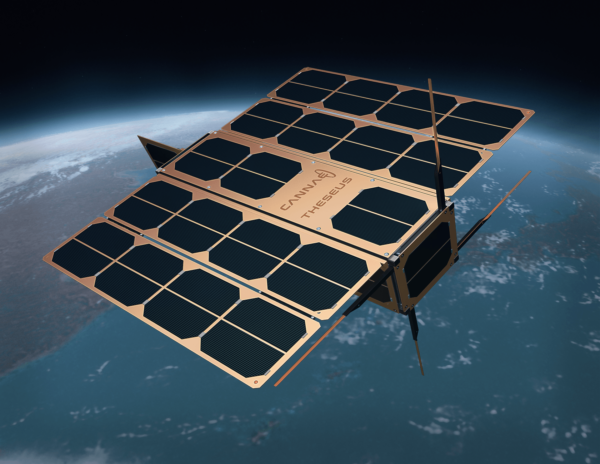 Image credit: Cannae.com at http://cannae.com/press-release-from-cannae/.
Image credit: Cannae.com at http://cannae.com/press-release-from-cannae/.
And finally, from Sinisa Lazarek, expressing what many people must be thinking: "seriously.. this again?"
What a lot of people don't realize is that AIAA is not a physics journal. They aren't concerned with someone's physical explanation for something, about whether it's legitimate or plausible or fringe or accepted or completely insane. What they are concerned with is the engineering, which is to say (in an overly simplified fashion), "If you build thing A, your device will do this thing B, and you will see that thing C." So you've got a device that you can build, and you test your your device to see if it does the thing you say it does, and then your report what you see, and then you've got an AIAA paper.
But that's not the same as having broken the laws of physics; it means you have a device that the people building and operating and testing it don't fully understand. It could be a herald of new physics, but the far more likely explanation is that there's something fundamental going on that the builders, operators and testers are missing. And if I'm wrong, I'll admit it as soon as the evidence matches up in quality to the magnitude of the claims being made. What I'll never understand is the credulity of those who don't require that.
My question for you is, "why don't you demand that?"
- Log in to post comments

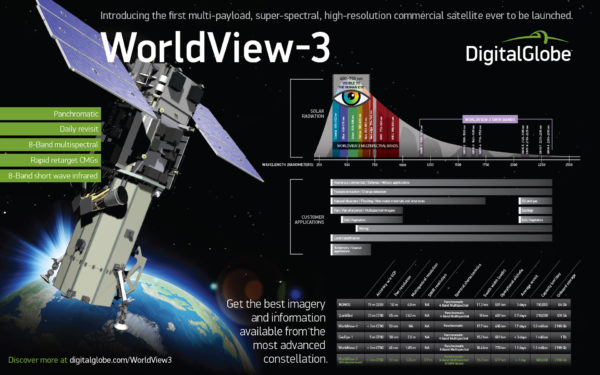
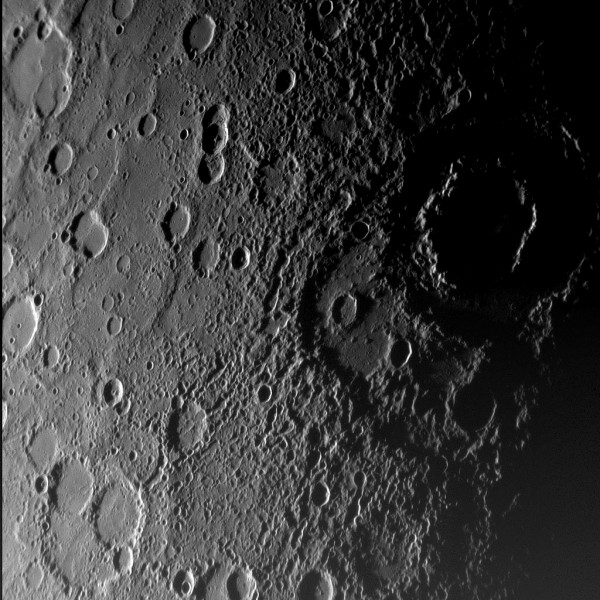
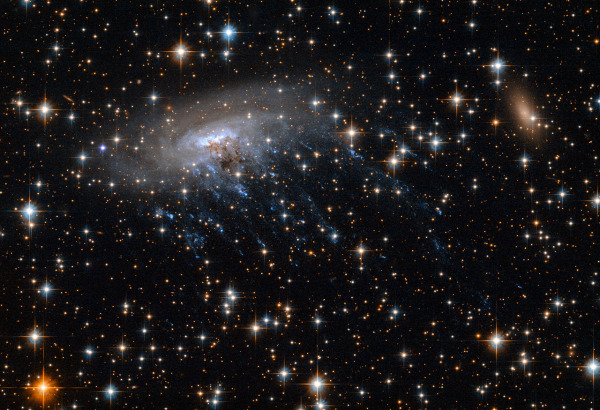


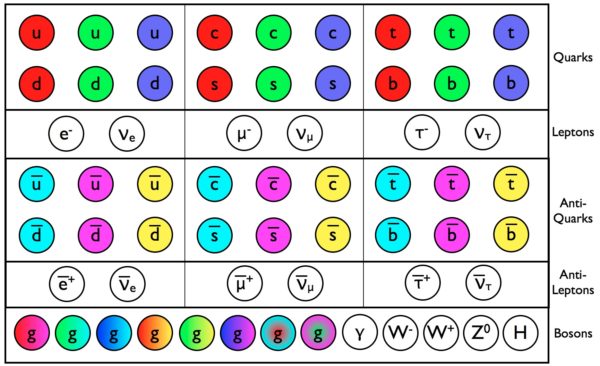
One oddity that Ethan has not yet covered is why Ceres and Pluto have liquid oceans beneath a frozen crust causing recent, ongoing and active cryovolcanism and regenerating atmospheres. Those dwarf planet should have been completely frozen over billions of years ago. There are no tidal forces afoot and radioactive isotopes why out there in the cold regions of space have long since stabilized.
We have conservation of energy and thermodynamics to consider but now what could be causing all that heat to form?
oh my oh my
@axil (#1): what makes you say that there are the radioactive isotopes on Ceres and Pluto are "stabilised"? There are many very long-lived radioactive isotopes out there that have half-lives in the billions of years: Potassium-40 (1.2 billion years), uranium-238 (4.4 billion years), and Thorium-232 (14 billion years). These three isotopes in particular are the most significant contributors to the radiogenic heating of the earth's interior, and there is no reason to think that these elements are so absent from elsewhere in the solar system.
How fast is the 99.99% Dark Matter Dragonfly 44 galaxy travelling through the interstellar medium as compared to the 26,000 kps of ESO 137-001 (the other galaxy pictured, I believe).
I can’t find that info anywhere.
Where are you getting the latter figure from? The radial velocity of ESO 137-1 is about 4630 km/s (SIMBAD). W—dia coughs up 6280 km/s for the former.
That was a bad conversion error on my part. It is a mere 2000 kps according to this link:
http://www.learnastronomyhq.com/latest-astronomy-news/super-fast-galaxy…
Which gives 4.5 million mph for ESO 137-001, much less than your figures.
Well, one also needs distance and proper motion to finish the job.
NASA Innovative Advanced Concepts (NIAC) had their 2016 symposium on August 23-25, 2016.
http://www.nextbigfuture.com/2016/09/nasa-innovative-advanced-concepts_…
https://www.nasa.gov/feature/experimental-demonstration-and-system-anal…
1. Sun light is focused onto deepsubwavelength metallic nanostructures through a lens
2. Resonant interaction and coupling of light with the nanostructure excites surface plasmon polaritons that generate a strong gradient optical force field
3. Nanoparticles (e.g., glass beads) are accelerated by the gradient force field and expelled at high speeds
Also see light speed photonic star drive on the video.
@Anonymous Coward
http://phys.org/news/2016-09-scientists-amount-fuel-earth.html
"Once we collect three years of antineutrino data from all five detectors, we are confident that we will have developed an accurate fuel gauge for the Earth and be able to calculate the amount of remaining fuel inside Earth," said McDonough.
The new Jinping detector, which will be buried under the slopes of the Himalayas, will be four times bigger than existing detectors. The underground JUNO detector near the coast of southern China will be 20 times bigger than existing detectors.
"Knowing exactly how much radioactive power there is in the
Earth will tell us about Earth's consumption rate in the past and its future fuel budget," said McDonough. "By showing how fast the planet has cooled down since its birth, we can estimate how long this fuel will last."
Read more at: http://phys.org/news/2016-09-scientists-amount-fuel-earth.html#jCp
Red Dwarf stars like our closest neighbor, Proxima Centari, are provocative … especially if they heat a habitable planet and are close enough to travel to (using the EMdrive ?).
This conjecture comes up today due to input from SciFi and SciAm concerning a recent fictional tale that turned out to be nearly true. You can read about that in the cite below, but there is further possibility that they don’t go into. No surprise. After all this is SciAm, what did you expect?
http://www.scientificamerican.com/article/the-book-that-predicted-proxi…
The least massive red dwarf has a few % the mass of the Sun but the temperature and pressures to support hot nuclear fusion is still there. However, if cold fusion of the type involving “ultradense hydrogen” is real (Holmlid effect) there is the outside chance that we will find a warmer Jupiter out there to fill in the gap between red dwarf and cold gas giant.
Maybe this is already found, since there is a little known class of large planets called “roasters”.
https://en.wikipedia.org/wiki/Hot_Jupiter
Back to Proxima Centauri, which is located just 4.2 light-years away and is only a little larger than Jupiter in diameter but more massive. Its planet is the about the size of Earth and is likely to be habitable. The smallest known dwarf star is a bit smaller. But if we dispose of the requirement of hot fusion as being the only heat source, then there could be another category between gas giant and red dwarf, which is the “roaster” category, yet without a nearby star to keep it hot.
In fact, although the cloud temperature of Jupiter is a chilly -145 degrees C, the temperature near the planet's core is a rather toasty 24,000 degrees C … which ironically is far hotter than the surface of the sun. Go figure. If a Jupiter-like planet had a larger iron-nickel core so that the hot zone is moved closer to the surface, then the cloud temperature could become balmy, due to more internal heat. The moons of such a Hot Jupiter would then be where to look for life.
Since Jupiter probably has a solid hydrogen core, it is indeed possible that unbeknownst to most cosmologists - one contributory heat source already is due to LENR. But if not, there still could be a more massive planet, or a less massive red dwarf, which is heated by the Holmlid effect (defined as ultra-dense hydrogen exposed to semi-coherent radiation on a catalyst).